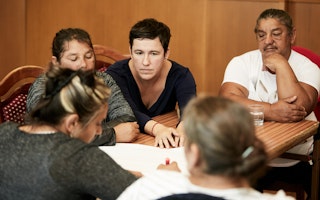Separate and Unequal
By Kritika Bansal
Growing up in the U.S., I was fortunate enough to have parents and teachers who always pushed me when it came to school. I had their encouragement and support, and the education I received has helped me to reach the place I am today. Throughout Europe, however, millions of Roma children are not so lucky.
Two weeks ago, filmmaker Mona Nicoara came to the Open Society Foundations to screen her film Our School. It documents the attempt to desegregate a local school in a small Transylvanian town. Going into the screening, I knew that Roma children all over Europe are often shunted into separate schools, but I was in no way prepared for just how moved I would be by the children of Târgu Lăpus and their struggle to receive something I had previously taken for granted—a decent education.
Our School follows the children for four years. The Roma there live on the outskirts of society and have limited access to everyday necessities like clean water. The girls are given the option of marriage or school; choosing both results in embarrassment and shame. The boys dream of being policemen so they can garner respect and eventually enough money to manage their own farms.
The social distance between the Roma and Romanians—so blatant to the viewer—is ignored by the local people in town. A teacher at the public school claims there are no problems between the Roma and Romanian children in her classes, yet during the film a child mentions that he and his friends do not like that he plays soccer during recess with his Roma classmates. The mayor says he draws no distinction between Roma and Romanians, yet he uses government funds to create a separate school for Roma children without explaining his reasons why.
Once the program to desegregate the schools begins, it seems that inclusion will bring real change for the students' lives. But with every promise of opportunity for the Roma children, disappointment and desolation prevails. As they prepare for their first day of school, the children are bright-eyed and joyous; one is so excited he demonstrates how quickly he will run from his home to the school in the center of town, a good four kilometers away. But once they reach the school, they quickly realize they do not own a pencil case or a notebook, in sharp contrast to the Romanian students who are well stocked with school supplies. And this is just the beginning.
The optimism the children exhibit on the first day of school is quickly crushed by the flagrant racism from both teachers and students. In one scene, while the students are outside for recess, a teacher tells the Roma children to collect trash from the school grounds while the Romanian children continue to play.
For the viewer it is clear that the Roma children want nothing more than to attend the school to learn and play with the non Roma students. But the school’s director and teachers only see an unwillingness to learn. In the end, the Roma students are sent to a remedial school as a result of their “delayed progress.” The school’s director decision is not a matter of segregation, but rather knowledge level. But the Roma children are smart enough to understand the underlying motive for their transfer: they are unwanted. In one especially moving scene, 16-year-old Benjamin sits in the remedial school classroom as a teacher stands next to him helping him color. “Stay in the lines,” she tells him. “You like this. [The coloring] cultivates your imagination.” Benjamin is told to “stay in the lines,” never let his marker leave the edges, just as he and other Roma are confined to the edges of society.
The passion for learning that the Roma children had at the outset of the movie diminishes once they are moved to the remedial school. They become disillusioned, feeling rejected by the system. By the end of the film, Dana, 20, is married with two children. She wistfully recalls her time in the school. “I didn’t have [my brain] screwed on right, I guess,” she says. You could see that without support from her teachers or confidence in her own abilities, Dana had resigned herself to her situation, believing she had no chance at finishing school.
The Open Society Foundations have advocated for change in policies affecting Roma and litigated to end school segregation. But Our School left me wondering how we can do more to remove the obstacles to Roma inclusion when it seems policy change is not enough. These children have the right to sit in the front of the classroom, not be banished to the back where they cannot be seen or heard. They have the right to the same education as any other child living in that town. But how can Roma children achieve their potential when they are not even given a chance?
Until July 2016, Kritika Bansal was a communications coordinator at the Open Society Foundations.


